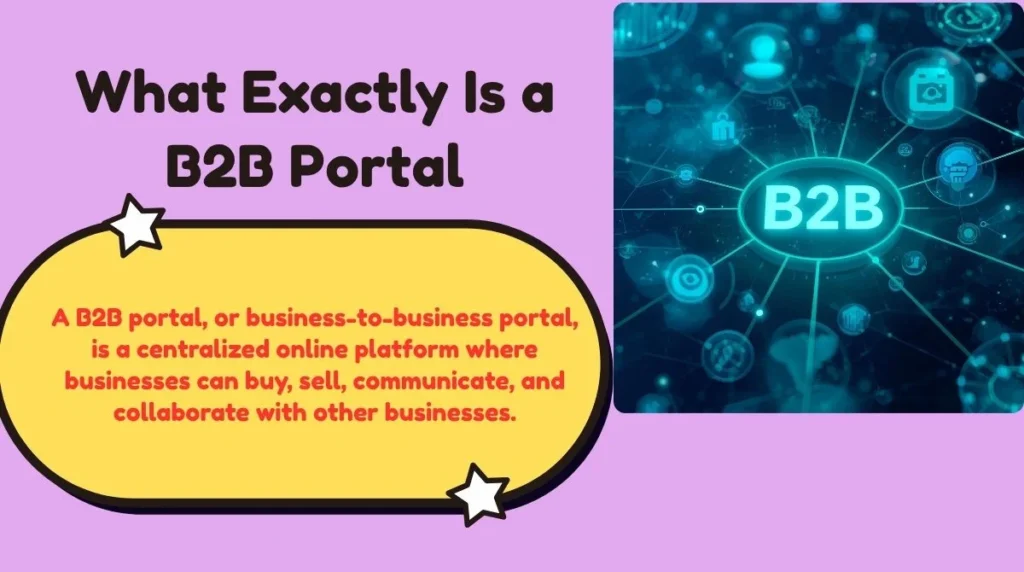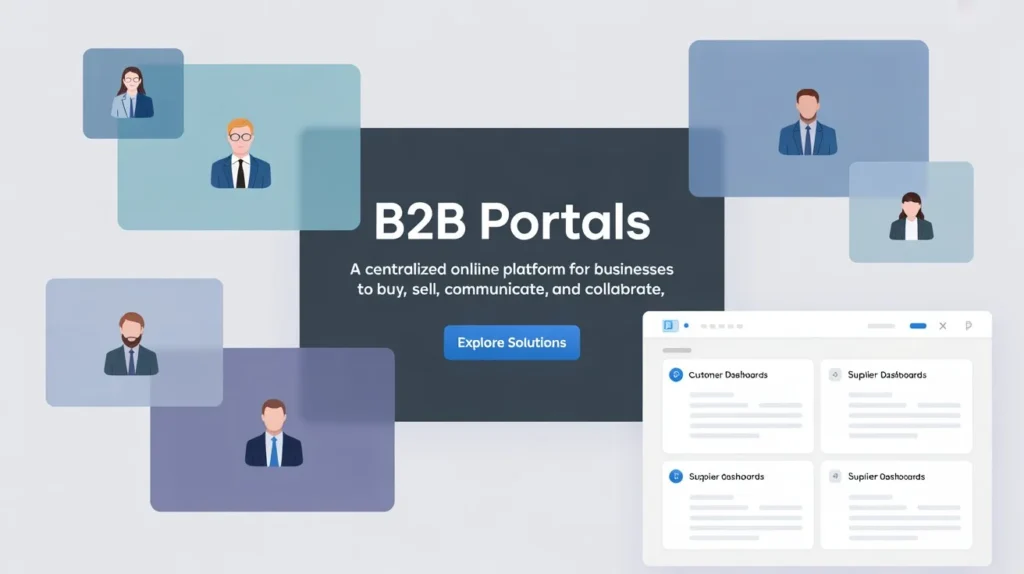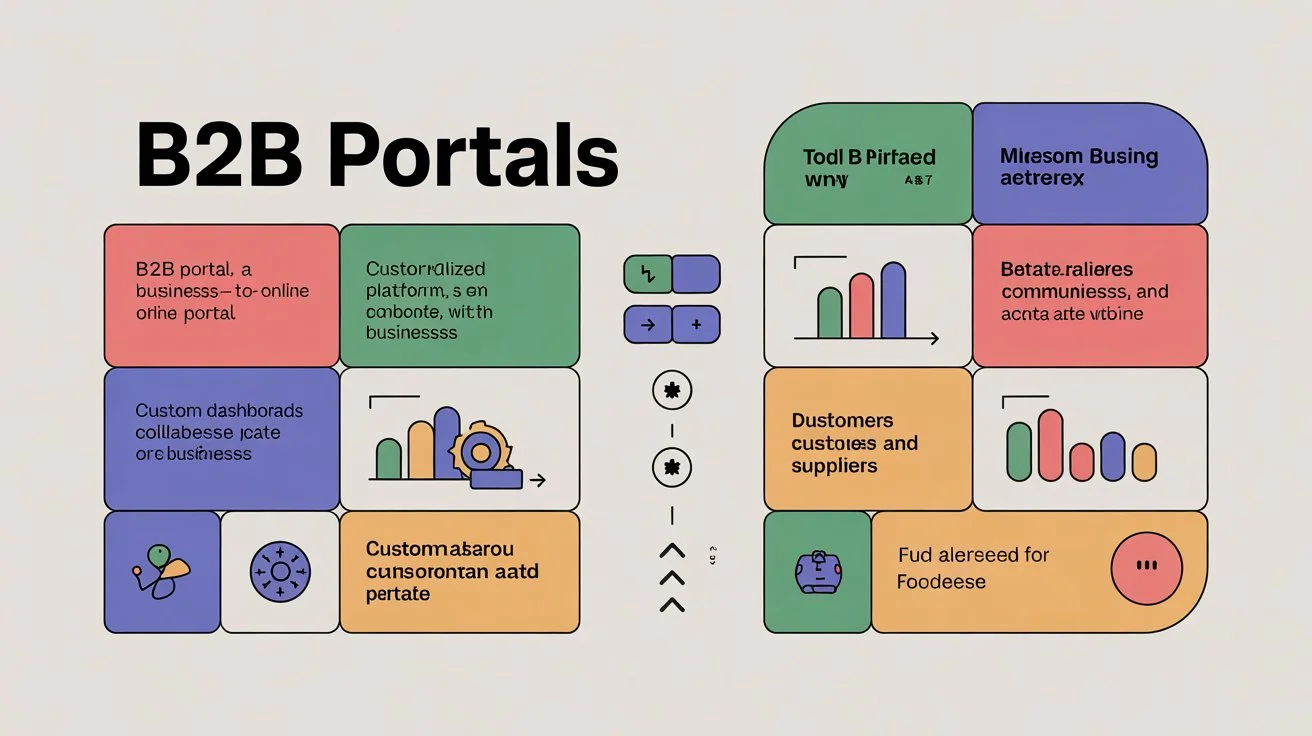In today’s rapidly evolving digital marketplace, B2B portals have become the backbone of modern business-to-business interactions.
Gone are the days when companies relied solely on emails, phone calls, and manual invoices to manage their operations. Now, digital platforms—tailored specifically for B2B transactions—empower organizations to connect, trade, and scale globally with ease.
This comprehensive guide breaks down everything you need to know about B2B portals—from how they work and why they matter, to real-world case studies and future trends driving innovation.
What Exactly Is a B2B Portal (and Why It’s More Than Just a Website)?

A B2B portal, or business-to-business portal, is a centralized online platform where businesses can buy, sell, communicate, and collaborate with other businesses. Think of it as a digital ecosystem that streamlines all commercial interactions under one roof.
Unlike a regular website, a B2B portal provides personalized dashboards, access control, and integration with internal systems like ERP or CRM. It’s not just an online storefront—it’s a complete business management tool.
Core Features of B2B Portals
- Custom dashboards for customers and suppliers
- Tiered pricing models and contract-specific rates
- Real-time inventory and stock visibility
- Automated order tracking and approvals
- Integration with ERP, CRM, and accounting tools
- Multi-user access with role-based permissions
Example:
Imagine a distributor logging into a manufacturer’s portal. Instead of waiting for manual quotes or invoices, they can instantly view product catalogs, see pricing based on their contract, place orders, and track shipments—all within minutes.
How B2B Portals Power a Winning B2B Commerce Strategy

A solid B2B commerce strategy starts with digital transformation—and portals are at the heart of it.
These platforms don’t just handle transactions; they help you understand customer behavior, automate processes, and create lasting business relationships.
Key Benefits:
- Automation: Eliminates manual order entry, reducing errors.
- Data-driven insights: Analytics reveal buying patterns and high-value customers.
- Customer retention: Portals simplify reordering and contract renewals.
- Integration power: Syncs with CRMs, ERPs, and marketing automation tools.
For example: A company selling industrial components can automatically send reordering reminders to clients based on their purchase history. That’s not just convenient—it’s smart selling.
B2B Portals vs. Traditional E-commerce Platforms
While e-commerce platforms cater to individual consumers, B2B portals are designed for business buyers with complex needs—like bulk orders, custom pricing, and multi-level approvals.
| Feature | B2B Portal | B2C E-commerce |
|---|---|---|
| Audience | Businesses | Consumers |
| Pricing | Tiered, negotiable | Fixed |
| Payments | Invoices, credit terms | Online payment |
| Integration | ERP, CRM, logistics | Basic |
| User Roles | Admins, buyers, managers | Single-user |
| Ordering | Bulk, recurring | One-time |
| Customization | High | Limited |
When to Choose a B2B Portal
- When your sales process involves negotiations or contracts.
- If you serve repeat clients or long-term partnerships.
- When you need deep system integrations for seamless operations.
In essence, B2B portals are the infrastructure that powers wholesale digital commerce.
What Modern B2B Buyers Actually Expect (and How to Deliver It)
Today’s B2B buyers expect the same speed, personalization, and transparency they get from B2C platforms like Amazon. According to Forrester, nearly 74% of B2B buyers research online before contacting a sales rep.
Top Expectations of B2B Buyers
- Instant access to product information and pricing
- Transparent processes with real-time updates
- Easy reordering options and repeat purchase features
- Personalized dashboards tailored to their company’s needs
- 24/7 customer support with live chat or AI assistance
To meet these expectations, your B2B portal should combine speed, simplicity, and intelligence.
“In the digital age, convenience isn’t a luxury—it’s a demand.”
Tip: Use AI-driven tools to recommend products or bundles based on past purchases. This adds value and boosts cross-selling opportunities.
The Real Value of a B2B Online Portal: From Sales Enablement to Long-Term Growth
A B2B portal isn’t just a sales tool—it’s a strategic growth engine.
By digitizing workflows and making data more accessible, businesses can focus on what really matters: relationships and results.
Strategic Advantages
- Faster Sales Cycles: Reduce back-and-forth communication with automated approvals.
- Reduced Costs: Minimize administrative work and manual order entry.
- Enhanced Visibility: Track every stage of the buyer journey in one place.
- Improved Loyalty: Give customers more control over their transactions.
Example: A construction supply company might see a 40% increase in recurring orders after deploying a user-friendly B2B portal with custom dashboards for every contractor.
Behind the Scenes: How a Well-Built B2B Portal Works
Let’s take a look at how a B2B portal actually functions from order to delivery.
Lifecycle of a Typical B2B Transaction
flowchart LR
A[Customer Inquiry] --> B[Quotation Request]
B --> C[Automated Approval]
C --> D[Order Placement]
D --> E[ERP Integration]
E --> F[Shipment & Tracking]
F --> G[Invoice & Reorder Reminder]
System Integrations
- ERP Integration: Synchronizes orders and inventory.
- CRM Connection: Tracks communication and sales data.
- Payment Gateway: Handles invoices and transactions securely.
- Analytics Dashboard: Measures KPIs and performance.
UX Design Matters
A clean, intuitive interface ensures faster adoption. Even in corporate environments, buyers want a portal that’s as easy to use as Amazon.
Real-World Case Studies: B2B Portals That Transformed Businesses
Case Study 1: Kippie – Digitizing Customer Relationships
Challenge: Kippie, a Dutch food supplier, struggled with manual order management and inconsistent pricing.
Solution: Implemented a B2B portal with automated ordering and personalized customer dashboards.
Result:
- 60% reduction in manual errors
- 35% increase in repeat orders
- Real-time visibility across all distributors
Case Study 2: Arizona Fireplaces – Scaling with Smarter Ordering
Challenge: Managing thousands of SKUs and customer-specific pricing.
Solution: Integrated ERP with a custom-built B2B portal.
Result:
- Cut processing time by 45%
- Improved order accuracy
- Boosted annual revenue by 20% within the first year
Case Study 3: Elite Manufacturing – Simplifying Complex Supply Chains
Challenge: Long approval cycles and fragmented communication between departments.
Solution: Adopted a cloud-based B2B portal with multi-level approval workflows.
Result:
- 50% faster procurement cycles
- Improved inter-department transparency
- Seamless data synchronization
The Future of B2B Portals: AI, Personalization, and Predictive Commerce
The next era of B2B portals is powered by artificial intelligence and predictive analytics.
Automation will no longer be optional—it will be the norm.
Emerging Trends
- AI-driven product recommendations
- Predictive reordering based on inventory cycles
- Chatbots and virtual assistants for instant support
- Smart analytics to forecast customer demand
- Voice-enabled ordering systems for faster interaction
Companies that embrace these technologies now will not just survive—they’ll dominate the next wave of digital commerce.
Building or Choosing the Right B2B Portal for Your Business
Choosing the right platform requires clarity, not guesswork. Here’s a quick checklist to guide you:
Essential Features
- Scalable infrastructure for future growth
- API support for integrations
- Advanced analytics for tracking KPIs
- Mobile-friendly design for on-the-go access
- Role-based access controls
- Multi-language and currency support
Implementation Tips
- Start small—pilot with one department or region first.
- Prioritize data migration and integration.
- Train your sales and support teams to use the system effectively.
Avoid these mistakes:
- Ignoring user experience
- Over-customizing too early
- Not defining clear KPIs before launch
Measuring Success: KPIs to Track in Your B2B Portal Strategy
You can’t improve what you don’t measure. Track performance using metrics that reflect both sales and customer satisfaction.
Key Metrics
| KPI | Why It Matters |
|---|---|
| Customer Lifetime Value (CLV) | Measures long-term profitability |
| Order Frequency | Tracks customer engagement |
| Average Deal Size | Indicates upselling effectiveness |
| Conversion Rate | Shows how well your portal drives sales |
| Portal Adoption Rate | Evaluates user acceptance and engagement |
Pro Tip: Use dashboards that visualize these KPIs in real-time. It helps managers make faster, smarter decisions.
FAQs About B2B Portals
What’s the difference between a B2B marketplace and a B2B portal?
A B2B marketplace connects multiple buyers and sellers (like Alibaba), while a B2B portal is a private, company-owned platform that manages direct business relationships.
How long does it take to implement a B2B portal?
Typically, between 3 to 6 months, depending on integration complexity and data migration needs.
Which industries benefit most from B2B portals?
Manufacturing, wholesale, construction, healthcare, and technology sectors gain the most from streamlined B2B operations.
Can a B2B portal integrate with existing systems?
Absolutely. The best portals integrate seamlessly with ERP, CRM, and accounting systems to maintain data consistency.
How secure are B2B portals?
Modern B2B portals use SSL encryption, two-factor authentication, and role-based access to protect sensitive business data.
Conclusion
A B2B portal isn’t just an IT investment—it’s a growth accelerator. It helps you connect smarter, sell faster, and scale seamlessly. As customer expectations evolve, businesses that adapt now will lead tomorrow’s digital marketplace.
“The companies that embrace digital transformation today will define the B2B commerce landscape tomorrow.”
So, whether you’re upgrading your existing platform or building from scratch, invest in a B2B portal that’s intelligent, scalable, and ready for the future.











